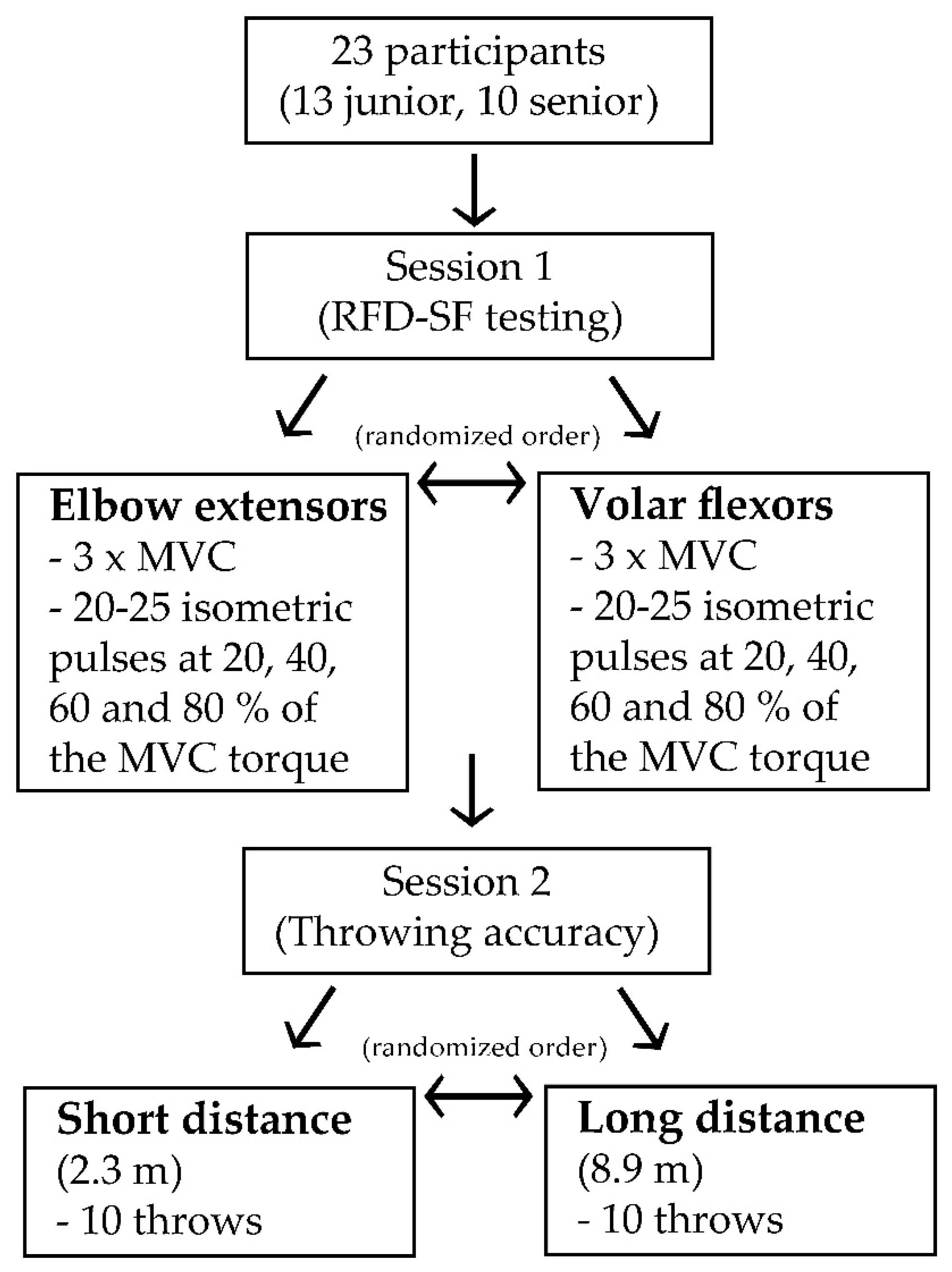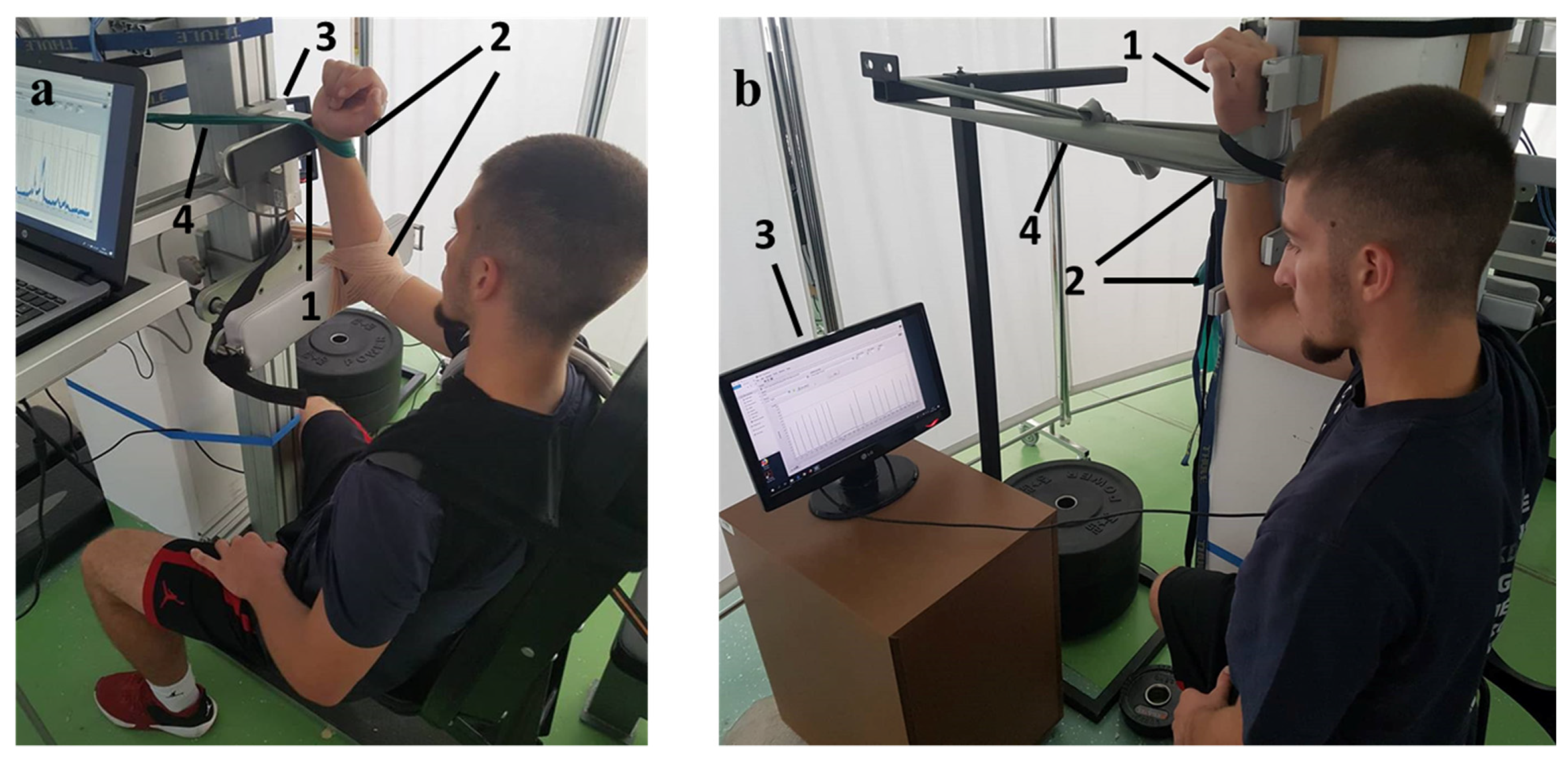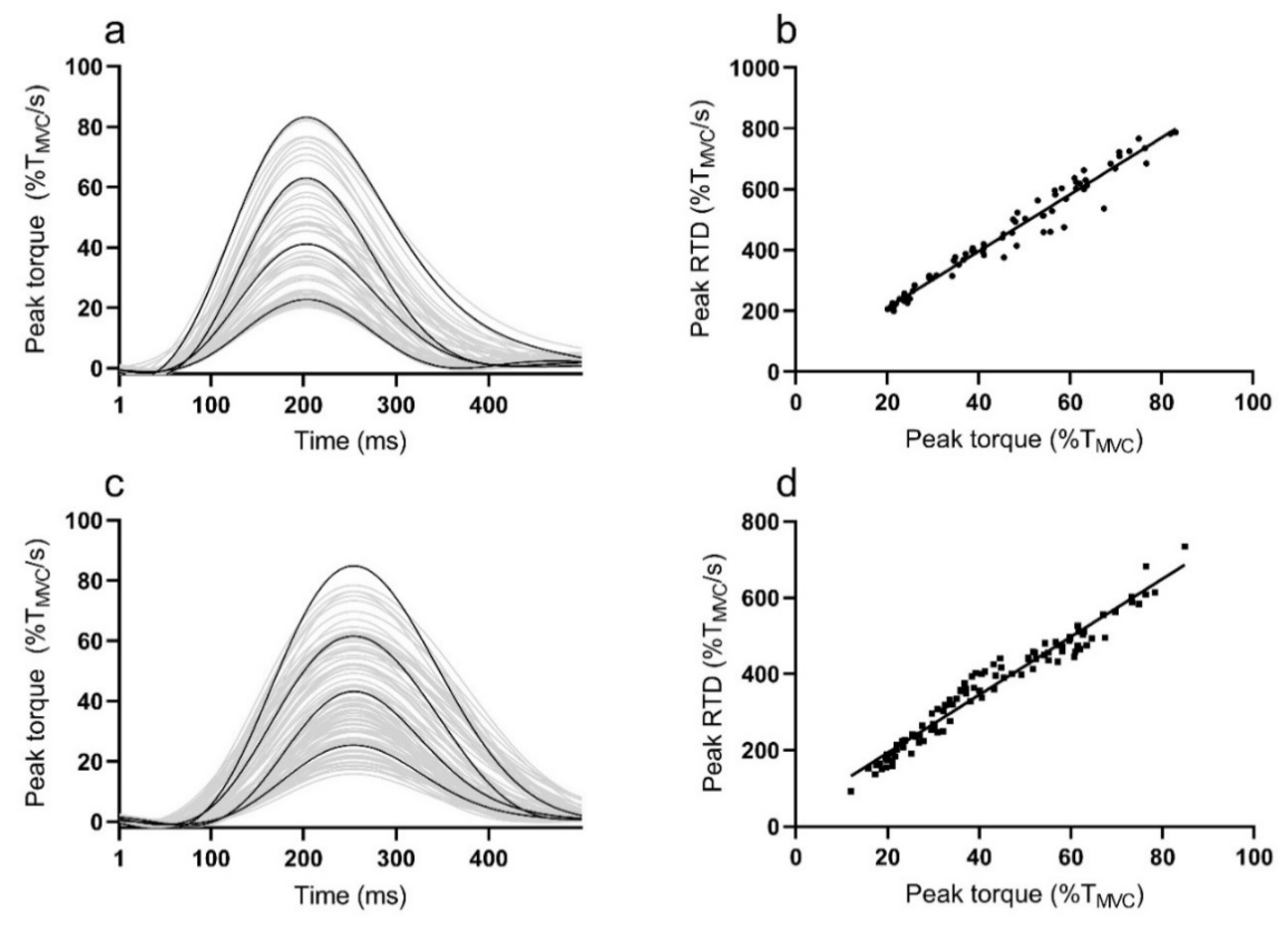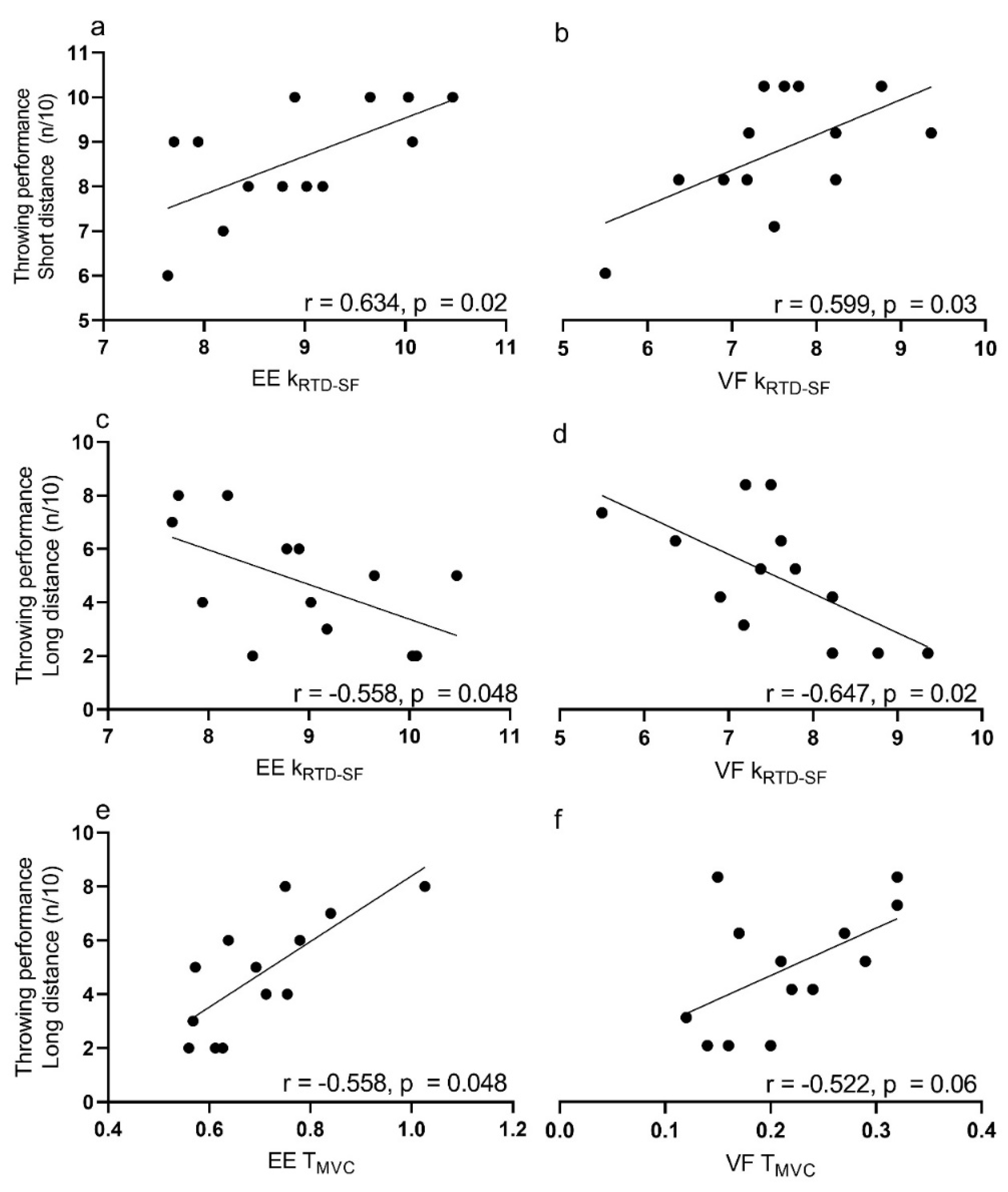1. Introduction
Rate of force development scaling factor (RFD-SF) has been used to quantify the ability to generate force rapidly, which is described as neuromuscular quickness [
1]. A large number of studies have reported the RFD-SF as a reliable method for a number of muscle groups such as index finger abductors [
1,
2], elbow extensors [
1,
3], knee extensors [
1,
4] and various hip muscles [
5]. However, the relationship between RFD-SF and performance in functional or sports-related tasks has not been yet investigated. It is known that muscle quickness decreases with age [
2] or disease [
6], while the influence of the specific training history on this ability is still, to a great extent, unknown.
Explosive and quick release during basketball shot is important to avoid the defender reaction. One of the studies showed positive effects of explosive strength training on the shot percentage level. However, explosive strength training was performed for upper and lower limb; therefore, it is unknown if upper limb strength capacities play important role in basketball shooting performance [
7]. We speculate that upper limb strength capacities may be important for accurate shooting performance because it has been reported that an increase in maximum strength of elbow extensors positively affected the shoot accurately in the three-point shot [
8].
Basketball shot is among the sports-specific movements in which rapid production of submaximal force by muscles that act across multiple arm joints is considered important. During a basketball throw, the players manipulate their shoulder, elbow, and wrist to generate the optimal ball speed and angular velocity of the joint at the time of the release [
9], depending on the distance and the position from the basket. The angular velocity of the upper arm joints and the speed of ball release increase with the shooting distance [
10], which suggests that higher submaximal involvement of the major muscle groups is required as the distance increases. The elbow extensors have been suggested as major contributors to release speed in basketball shooting [
11,
12] as they extend the elbow joint before release, while the activation of the volar flexors is an important component of shooting that optimises impulse applied to the ball at release [
13]. Previous studies have reported that the angular velocity of the elbow joint of the shooting arm at release increases with distance from the basket, while the opposite is observed for the wrist [
11], suggesting that the roles of the two joints vary with the shooting distance. Some earlier studies reported that players with more training experience had better shooting performance [
12,
14] and lower average duration of arm muscle activation [
15,
16]. Based on this, we assumed that junior and senior players might also differ in the neuromuscular quickness of the major shooting muscles (i.e., elbow extensors and volar flexors). Furthermore, the relationship between neuromuscular quickness and performance of sport-specific tasks has not yet been investigated. Filling these missing gaps could contribute to better understanding of RFD-SF and its use during routine testing of the athletes and possibly, based on these assessments, to individualized guidance of training programmes (e.g., more emphasis on speed-power training for individuals with lower RTD or RTD-SF).
To contribute our part in clarification of the functional role of the RTD-SF in sport-specific performance, we conducted a study to investigate strength capacities of elbow extensors and volar flexors in two groups of basketball players (juniors and seniors) and their relationship to shooting performance, put into the sport-specific training history. Specifically, the first aim of our study was to investigate the differences in the strength capacities (RTD-SF slope (kRTD-SF), maximum torque (TMVC), and peak rate of torque development (RTDPEAK) of elbow extensors (EE) and volar flexors (VF) and the shooting performance between junior and senior basketball players. We hypothesised that senior players, based on their longer training history and complete physical development, have significantly higher strength capacities of elbow extensors and volar flexors and better shooting performance compared to junior players. The second aim of the study was to investigate the relationship between the strength capacities (kRTD-SF, TMVC, and RTDPEAK) and shooting performance. We hypothesised that in both groups, shooting performance would be significantly positively associated with kRTD-SF, TMVC, and RTDPEAK of elbow extensors and volar flexors, at least from the long shooting distance. The third aim of the study was to investigate associations of elbow extensors and volar flexors as previous studies showed positive associations of kRTD-SF ability for different muscle groups, while this association between elbow extensors and volar flexors has not yet been confirmed. We hypothesised that there will be a large and statistically significant association in kRTD-SF between elbow extensors and volar flexors in both groups of players, which might support the idea of a central regulation and upper extremity (not a single joint, i.e., muscle group) related characteristics of RTD-SF ability.
3. Results
The reliability of the outcome variables is shown in
Table 2. For both muscle groups RTD-SF and T
MVC showed very good reliability (all ICC ≥ 0.85; all CV ≤ 5.66%); however, the reliability was somewhat lower for RTD
PEAK, especially for the VF muscles (ICC = 0.54; CV = 15.21%).
Junior players had a significantly lower average number of training years (5.5 ± 1.8 years) compared to senior players (14.1 ± 3.8 years) (t
(21) = −7.2,
p < 0.013). There was no statistically significant difference in height between groups (t
(21) = −1.6,
p = 0.11), while senior players had statistically significantly higher body mass (t
(21) = −3.4,
p = 0.003) and body mass index (BMI)(t
(21) = −3.0,
p = 0.007). Average k
RTD-SF, T
MVC, and RTD
PEAK values of elbow extensors and volar flexors in junior and senior group are presented in
Table 3. Junior and senior players had similar values of T
MVC in both muscle groups, while junior players had significantly greater RTD
PEAK of EE and VF (
p = 0.003–0.005, ES = 0.35–0.36). For both groups, a strong linear relationship (r
2RTD-SF = 0.93–0.95) between the peak force and the RFD across submaximal contractions was calculated for both muscle groups (sample recordings are presented in
Figure 3). There was no statistically significant difference in k
RTD-SF between junior and senior players for elbow extensors or volar flexors. There was no difference in shooting performance from long distance, whereas senior players were more successful from short distance.
Significant associations between k
RTD-SF, T
MVC, RTD
PEAK (EE and VF) with shooting performance for junior players are presented in
Figure 4. We calculated a large positive association between k
RTD-SF of EE and VF and shooting performance from short distance (
Figure 4a,b), while significant negative large associations were seen between k
RTD-SF of both muscle groups and shooting performance from long distance (
Figure 4c,d). Moreover, a significant positive large association was calculated between T
MVC of EE and shooting performance from long distance (
Figure 4e), while the association between T
MVC of VF and shooting performance was not statistically significant (
Figure 4f). No statistically significant associations were calculated in junior players between RTD
PEAK of both muscle groups and shooting performance (r = 0.246–0.315,
p = 0.48–0.49). There were no significant associations between T
MVC, RTD
PEAK, or k
RTD-SF (EE and VF) and any shooting performance in senior basketball players (r = −0.481–0.481,
p = 0.15–0.55) or in both groups combined (r = −0.366–0.271,
p = 0.16–0.87).
Significant positive large associations between kRTD-SF of elbow extensors and volar flexors were calculated for senior group (r = 0.677, p < 0.05) and when both groups were evaluated together (r = 0.615, p < 0.001), while associations between kRTD-SF of elbow extensors and volar flexors in junior group were not statistically significant (r = 0.514, p = 0.72).
4. Discussion
The first aim of our study was to investigate differences in strength capacities of elbow extensors and volar flexors and shooting performance between junior and senior basketball players. Our results showed similar kRTD-SF of both muscle groups between juniors and seniors regardless of significant differences between the two groups regarding training history, body mass and BMI. Similar values were also observed for TMVC of both groups, while juniors had significantly greater RTDPEAK (normalized to body weight). Seniors showed better shooting performance only at short distance compared to junior players. The second aim was to investigate associations between strength capacities and shooting performance. Significant associations between kRTD-SF of both muscle groups and shooting performance were found only in juniors. Our results revealed significant positive association between kRTD-SF of elbow extensors, volar flexors and shooting performance from short distance. On the contrary, a significant negative large association was found between kRTD-SF of both muscle groups and shooting performance from long distance. TMVC of elbow extensors was found to have a significant positive large association with shooting performance from long distance. Our third aim was to investigate associations in kRTD-SF of elbow extensors and volar flexors. Our results showed significant positive large associations between kRTD-SF of elbow extensors and volar flexors.
In this study, we investigated the k
RTD-SF, T
MVC, and RTD
PEAK of two major groups of arm muscles that generate force that is necessary for the execution of the basketball shot. RTD-SF has already been shown to be sensitive to changes in neuromuscular function associated with age [
2] and disease [
6]. As it was shown that explosive strength training positively influences shooting accuracy in basketball players [
7], and moreover, there are some indices that maximum strength of elbow extensors is positively associated with shooting accuracy in the three-point shot, our goal was to further investigate the relationship between upper limb strength capacity and shooting performance. We hypothesized that a sport-specific movement that is constantly repeated (such as basketball shooting) might have an influence on strength capacities (k
RTD-SF, T
MVC, and RTD
PEAK) of the responsible muscle groups, and in addition, it might be dependent on the training history and physical development. On this basis, we evaluated differences between junior and senior basketball players in terms of k
RTD-SF, T
MVC, and RTD
PEAK of EE and VF. The senior basketball players had significantly longer participation in basketball training and consequently greater experience and completed maturation.
Previous studies have shown that players with more training experience had better free-throw performance compared to less-experienced players [
12,
14]. Moreover, it was shown that explosive strength training of upper and lower limb improves basketball shooting accuracy [
7]. In our study, we investigated shooting performance from shorter and longer, as different shooting distances may require different involvement of muscle strength capacities. Although it is known that muscle growth is occurring in boys until 17.5 years of age [
19], our results showed that juniors and seniors had similar strength capacities of elbow extensors and volar flexors, with the exception of RTD
PEAK. Significantly larger normalized RTD
PEAK in junior players can be explained with their lower body mass index (
Table 1), since it is known that lean body mass is associated with greater RFD/RTD [
20]. On the other hand, differences in abilities such as k
RTD-SF, which is independent of the body mass and muscle size, have not yet been investigated in relation to age. T
MVC of elbow extensors, volar flexors as well as k
RTD-SF values of both muscle groups showed similar values in junior and senior basketball players (
Table 3). There is a paucity of literature analysing the differences in muscle capacity between junior and senior elite basketball players, especially regarding the upper body. A previous study reported that senior basketball players produce significantly higher absolute power with lower extremities [
21]. Our data suggest that there is no difference in neuromuscular quickness (as tested by k
RTD-SF), between juniors and seniors. On the other hand, some studies that assessed shooting and passing actions showed that more experienced basketball players exhibit a shorter duration of muscle activation of the arm muscles [
15,
16]. This could be due to the changes in motor pattern activity associated with increasing skill [
22] and not due to the changes in neuromuscular quickness. In accordance with previous studies [
12,
14], we have also confirmed that the players with more training experience have better shooting performance, but only from short distance. It is known that the shooting movement pattern changes with greater shooting distance, while its accuracy significantly decreases [
23]. Overall, our results suggest that senior players do not have higher strength capacities compared to junior players, while they are equalized in shooting performance at long shooting distance. Thus, we can reject our first hypothesis.
Shooting performance was related with k
RTD-SF and T
MVC only in junior players. This result suggests that muscle abilities such as neuromuscular quickness and T
MVC play an important role in shooting performance only in junior players, whereas in seniors their shooting muscles exceed the level of strength capacities required for successful shooting performance. In more experienced players, the shooting performance is influenced by the pattern of muscle activity (i.e., shorter or longer duration from the beginning of muscle activity, lower average activation time) [
15,
16] and likely not by the capacity of the shooting muscles. A very strong positive association between elbow extensor T
MVC and shooting performance from long distance shows that muscle strength is more important for shooting performance from longer distance in juniors compared to seniors. On the contrary there was no associations between T
MVC and shooting performance from short distance. Junior players with higher elbow extensors T
MVC were more successful at shooting performance from a long distance (
Figure 4e), which highlights the importance of muscle strength in the accuracy task from such distance. We can speculate that junior players with a smaller T
MVC were closer to their maximum strength capacity when they performed shots from a greater distance. This can be supported with findings from one study, which showed that the accuracy decreases when the shot is performed closer to the maximal strength capacity [
24]. Such associations have been only approaching statistical significance for volar flexors. Likely, it seems that the elbow extensors play a more important role than wrist muscles in providing the force required for the ball to reach the basket at greater distances [
11]. On the other hand, RTD
PEAK was not associated with shooting performance which could be explained by the fact that basketball shots are not performed under conditions that acquire maximal rate of force development.
Significant large positive associations were calculated between k
RTD-SF of both muscle groups and the shooting performance from short distance in juniors, while k
RTD-SF of both groups was in large negative association with long distance. It seems that the execution of the shot from short distance was better suited to junior players with greater k
RTD-SF, while the opposite holds true for the long-distance shots. A negative association between k
RTD-SF and shooting performance from long distance indicates that players with greater k
RTD-SF have worse shooting performance from long distance. It is already known that basketball shots are performed at higher velocities as the distance from the basket is increased [
13], while lower velocities are related to greater movement accuracy [
25]. It has been shown that weaker players who are unable to generate sufficient force must use a strategy of generating greater segmental velocities in order to execute a shot [
26]. Shot execution at higher velocities (due to the greater distance) increases body segments movement variability and decreased movement consistency [
27], while shooting performance at lower velocities provides additional time and thus allows players to perform movement corrections with visual and proprioceptive feedback [
28]. This could be supported by the results of another study in which novice handball players reduced their shooting accuracy when the shooting speed was increased, while this had no effect on the shooting accuracy of expert players [
29]. However, we did not measure the kinematic characteristics of shot execution, which would be valuable information for further explanations of measured associations.
In addition, similar investigation on a larger sample size would be needed for further conclusions together with the kinematic analysis of the shot from few shooting distances, while contribution from lower limb should be also considered. Finally, although the sensors used to acquire force data were high-quality load cell models, the reliability of the exact set-up, as used in this study, has not been checked before. The inter-repetition reliability of the outcome variables was, however, mostly very good. Notably, RFDPEAK had kRTD-SF, which supports that the latter could be an important addition or alternative to commonly performed assessments (TMVC and RTDPEAK).











